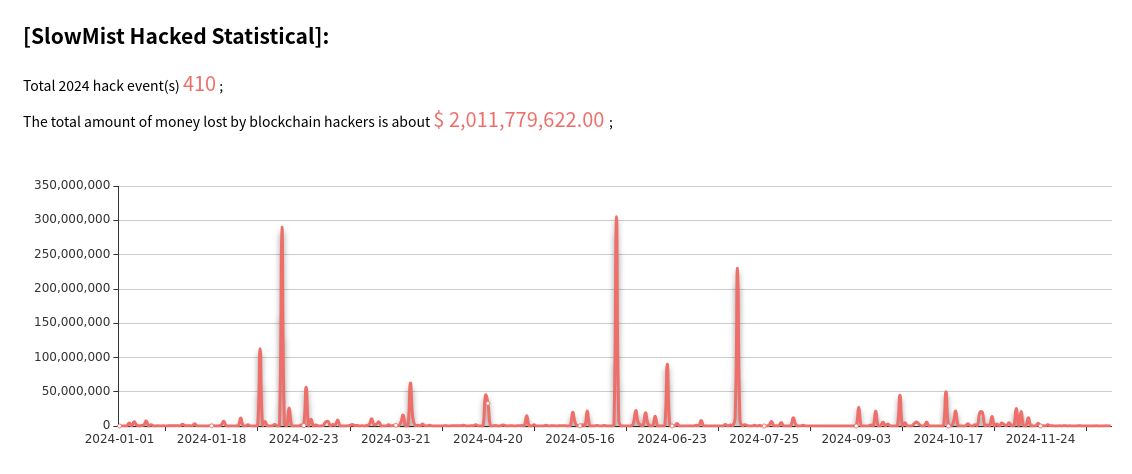Bitcoin 2024 Annual Review

I’ve always been fascinated with the raw numbers relating to the operational status and growth of Bitcoin, especially as we ride the rollercoaster of the adoption life cycle. This interest spurred me to create Statoshi.info in 2014 to track bitcoin metrics from the perspective of a full node.
To that same end, I’ve compiled statistical measurements of Bitcoin’s growth in 2024 from a variety of sources. It can be difficult to see all of the moving pieces since the data is so distributed, but the picture becomes clearer when you bring them all together.
The one theme that I've taken away from all of these metrics is that 2024 is that the bull market is underway, but a lot of folks have yet to catch on - we're far from peak hype and FOMO.
Bitcoin is at the forefront of an increasingly complex ecosystem that continues to grow in a variety of ways. And for the 16th straight year, it stubbornly refused to die! Not only that, but it appears that the critics have given up on publicly pronouncing its death.
RIP Bitcoin Obituaries pic.twitter.com/6s8C70u1yz
— Jameson Lopp (@lopp) December 24, 2024
Source: https://99bitcoins.com/bitcoin-obituaries/
I've noticed new coping narratives spread amongst the haters that "even Madoff's scheme lasted 16 years" and "the market can remain irrational longer than you can remain solvent." I suspect a lot of these folks will continue hating Bitcoin until it outlasts even them.
General Interest
The new entrant this year for relative search interest is... Switzerland! Not only does Switzerland have the Plan B initiative in Lugano, several large Swiss banks support Bitcoin and there's a decent amount of advertising for it all over the country.
Countries with highest relative search interest for Bitcoin were mostly unchanged in 2024. El Salvador remains Bitcoin country while Switzerland rose to 2nd place, likely thanks to Lugano. pic.twitter.com/HSbgfo3Tpe
— Jameson Lopp (@lopp) December 27, 2024
General interest in educational resources remained low. This makes sense, as we tend not to see many new entrants until the FOMO phase of peak bull market hits.
Visitors to my educational Bitcoin resources went up 20% year over year to 91,000. pic.twitter.com/Yp4gwOuXgJ
— Jameson Lopp (@lopp) December 28, 2024
X was chatter up a fair amount, mostly around the major events like price action, the halving, and the US election.
140 million posts containing the word "bitcoin" were published on X in 2024, an increase of 65% year over year.
— Jameson Lopp (@lopp) December 26, 2024
H/T @visibrain pic.twitter.com/HmAxRRr4pB
The bitcoin subreddit saw more significant growth.
/r/bitcoin subscribers increased by another 25% in 2024 to 7,470,000 pic.twitter.com/P0qIeae5s9
— Jameson Lopp (@lopp) December 26, 2024
I myself abandoned BitcoinTalk many years ago because I felt it was hard to find signal through the noise. It looks like user growth on that site decelerated even more in 2024.
BitcoinTalk total registered users only increased 2% to 3,662,000. pic.twitter.com/8kAbp02zuc
— Jameson Lopp (@lopp) December 28, 2024
Academic Interest
Academic interest seems to be reaching a saturation point - 30,000 references per year is quite a lot!
Google Scholar Articles Mentioning Bitcoin
— Jameson Lopp (@lopp) December 28, 2024
(note: 2024 will ⬆️ due to listing lag) pic.twitter.com/y9ykR82uC6
Source: https://scholar.google.com/scholar?q=bitcoin&hl=en&as_sdt=1%2C34&as_vis=1&as_ylo=2024&as_yhi=2024
The hardcore cryptographers have lost more interest.
Cryptology ePrint Archive Papers Mentioning Bitcoin pic.twitter.com/9yfdeA7T5G
— Jameson Lopp (@lopp) December 28, 2024
Source: https://eprint.iacr.org/search?q=bitcoin&title=&authors=&category=&submittedafter=2024&submittedbefore=2025&revisedafter=&revisedbefore=
Funding and Forking
VC investment fell off a cliff in 2022 as the bear market and credit crises hit full stride. As I predicted in last year's report, venture capital is starting to return along with the bull market.
Venture Capital funding in the crypto industry rose 28% year over year to $13.6 billion after suffering a massive drop during the bear market. pic.twitter.com/adIdWYJc80
— Jameson Lopp (@lopp) January 3, 2025
Interestingly, this bull market seems to be a bit different in terms of market cap dominance. I suspect a few things are going on:
- A lot of value is flowing to bitcoin via ETFs and institutions and there's no similar avenue or interest for that money to flow into altcoins.
- The SEC's heavy handedness over the past few years has put a damper on coins that are likely to be deemed unregistered securities, so now a lot of the degen gambling is happening in memecoins that make no promises of anything. These memecoins tend not to have much longevity.
Bitcoin's market cap dominance remained strong throughout 2024, ranging between 50% and 60% pic.twitter.com/vmv9S75Qb2
— Jameson Lopp (@lopp) December 29, 2024
On the other hand, the "fast, cheap payments" narrative has not played out well for Bitcoin forks like Cash and Satoshi Vision. This is a highly competitive arena in which dozens if not hundreds of altcoins can claim to be "the best." And of course, Bitcoin itself continues to compete in this space via Lightning Network, which we'll cover later.
Despite a spring pump, the BCH fork closes out the year down another 22% against BTC. It's now worth a mere 0.47% of the real Bitcoin. pic.twitter.com/cmE5ASwnJr
— Jameson Lopp (@lopp) December 29, 2024
Source: https://www.tradingview.com/symbols/BCHBTC/
Going down even further down the forking rabbit hole, BSV has been battered all year long as Craig Wright lost court case after court case, finally suffering a humiliating defeat against COPA that forced him to publicly proclaim he is not Satoshi Nakamoto.
The BSV fork managed to lose another 75% against BTC in 2024. It's now worth a mere 0.05% of the real Bitcoin. RIP @CalvinAyre & everyone who was dumb enough to fall for Craig Wright's lies. pic.twitter.com/DaqRcQuGTk
— Jameson Lopp (@lopp) December 29, 2024
Source: https://www.tradingview.com/symbols/BSVBTC/
On-Chain Transactions
While development of Lightning Network made more progress in 2024, due to its stronger privacy features we’ll always have more accurate statistics of on-chain activity.
Bitcoin's daily adjusted transfer value (excluding likely change outputs) hit $9.3B per day in 2024, over 9X vs 2023. pic.twitter.com/cU9fuMvW1z
— Jameson Lopp (@lopp) January 3, 2025
A more controversial aspect of the changing nature of bitcoin is the transaction fees. Rising fees caused significant frustration for users trying to transact in smaller amounts of value during late 2017 and early 2018, but fees were nearly 0 for the following 2 years due to a variety of factors. Lower transaction demand, improved fee estimation algorithms, adoption of segregated witness, transaction batching, and lightning network resulted in more efficient use of block space and less contention for this scarce resource.
Revenue collected via transaction fees by bitcoin miners averaged $2,500,000 per day in 2024. This is an increase of 25% year over year. pic.twitter.com/dLhNsvMNQK
— Jameson Lopp (@lopp) January 3, 2025
2024 was interesting regarding mining fees because we set new overall highs in terms of USD, but not in terms of BTC. There were several spikes in demand for block space throughout the year that led to this outcome, because demand was otherwise close to 0.
Transaction fees collected by #Bitcoin miners yesterday tripled the previous all-time high, coming in at over $78,000,000.
— Jameson Lopp (@lopp) April 21, 2024
We also made a new record streak of 104 blocks in which fees exceeded newly created BTC! pic.twitter.com/WZkCQ8dbr3
Bitcoin saw its longest ever streak of fees exceeding block subsidy this year (for 104 blocks after the halving.)
— Jameson Lopp (@lopp) January 3, 2025
However on average miners only received 5% of their revenue from transaction fees in 2024. pic.twitter.com/t03NE2kuCq
In short, we're still a ways away from having a sustainable thermodynamic security budget.
Demand for bitcoin block space was mostly muted in 2024, with spikes usually occurring during temporary token minting periods. pic.twitter.com/luOajGlKwh
— Jameson Lopp (@lopp) December 29, 2024
Source: https://statoshi.info/d/000000017/fee-estimates?viewPanel=1&orgId=1
Despite the bear market for block space, Bitcoin miners are doing well due to the rise in the exchange rate.
Bitcoin miners earned $15B in revenue in 2024. This assumes they instantly sell for fiat, which is not the case - miners tend to be HODLers. pic.twitter.com/NI94J1bU77
— Jameson Lopp (@lopp) December 31, 2024
UTXO set growth usually rises, though it seems to have plateaued in the latter half of the year. It's possible that cheap block space has encouraged more UTXO consolidations. The rise in Runes may have also contributed here, because they use OP_RETURN outputs that don't create UTXOs.
Bitcoin's UTXO set grew from 153.4M to 186.4M during 2024, adding 1 net additional UTXO per second. pic.twitter.com/NZZCpnd1G0
— Jameson Lopp (@lopp) January 3, 2025
Source: https://statoshi.info/d/000000009/unspent-transaction-output-set?viewPanel=6&orgId=1&refresh=10m&from=now%2Fy&to=now%2Fy
Bitcoin Data Anchoring
While you may think of bitcoin as being a cryptocurrency, some users think of it as a trust anchor. By embedding data into Bitcoin’s blockchain, other systems can gain new properties such as tamper evidence and immutability.
The amount of outputs that embedded data into the blockchain increased at an unprecedented rate in 2019, mostly due to Veriblock's "proof of proof" mining coming online that eventually died out due to being economically unsustainable. Use of OP_RETURN was on the decline for 4 years until the launch of Runes.
Bitcoin OP_RETURN (data anchor) outputs created in 2024 surged to an all-time high of over 80,000,000. This is entirely due to the popularity of the Runes protocol that launched at the halving in April. pic.twitter.com/JxfhP3x8jU
— Jameson Lopp (@lopp) December 26, 2024
Source: https://txstats.com/d/000000014/op_return-statistics?orgId=1&viewPanel=3
But OP_RETURN isn’t the only way to anchor other systems onto Bitcoin’s blockchain. Sidechains use pegging mechanisms to cryptographically lock BTC on the main chain and then allow users to unlock a proportional amount of tokens on a sidechain. This allows for experimentation with other features that are unlikely to be added to the Bitcoin protocol. For many years the only two production sidechains were RSK and Liquid. As of today there are over a dozen networks that may claim to be sidechains, though I'm skeptical of their security properties. The landscape of Bitcoin Layer 2 projects has become much more diverse over the past year and it's hard to keep up!
The Bitcoin hashrate that is merge mining the @rootstock_io sidechain decreased from 47% to 45% during 2024. (https://t.co/E1TCoBOUm5)
— Jameson Lopp (@lopp) December 31, 2024
The amount of BTC pegged into rootstock decreased from 3,210 to 2,873. (https://t.co/rgXWPn2f1W)
I'm told that the realtime stats site isn't particularly accurate and Rootstock is merge mined by more like 55% of the total hashrate.
Blockstream's Liquid sidechain also saw negligible growth in 2024.
During 2024 the amount of BTC pegged into the @Liquid_BTC sidechain increased by 1% to 3,784. pic.twitter.com/QZPhDt4vFh
— Jameson Lopp (@lopp) December 31, 2024
Source: https://liquid.net
Lightning Network
The observable network remained fairly flat in 2024. It seems like we saw some liquidity consolidation as plenty of channels were closed, but major operators seem to be reporting that they are able to achieve better results with less liquidity now.
Lightning Network in 2024:
— Jameson Lopp (@lopp) December 31, 2024
# advertised channels ⬇️ 15% to 55,502
# nodes with channels ⬆️ 4% to 17,252
Bitcoin in those channels ⬆️ 1% to 5,193
Network USD value ⬆️ 148% to $499M
NOTE: unadvertised channels and their value can't be measured.
Source: Glassnode Studio
The average Lightning Network channel capacity increased 27% from 7.5M to 9.5M sats in 2024. pic.twitter.com/WH5x2aVEj7
— Jameson Lopp (@lopp) January 3, 2025
Source: Glassnode Studio
This seems to support the idea that many of the channels that were closed were those with smaller liquidity capacity. I'm told that there are several major players that operate high capacity private channels with each other but we have no way of verifying this rumor.
DeFi
While many like to point out that there is "more bitcoin on Ethereum than Lightning Network" these figures are hardly comparable because the security models are completely different. There has been some drama in WBTC land as BiT Global came in and took over majority ownership of the project, which seems to have led to Coinbase delisting it from their platform because they claim that BiT Global is affiliated with Justin Sun.
The total supply of wrapped bitcoin fell another 16% during 2024 and it now sits at 132,350 WBTC. pic.twitter.com/uAdr3GQQmT
— Jameson Lopp (@lopp) January 3, 2025
Up until this year my understanding is that the underlying BTC for WBTC were custodied by BitGo, but along with Bit Global's involvement they appear to have transitioned to a multi-jurisdictional custody arrangement. Nonetheless, I still think of the WBTC supply as more akin to a "balances on exchanges" metric.
Network Security and Health
The number of Bitcoin nodes started inching back up this year. While relatively few BTC investors run nodes, this is a good indication of more hardcore enthusiasts and more enterprises adopting Bitcoin.
Reachable Bitcoin node count increased by 19% during 2024 to 20,367 according to Bitnodes pic.twitter.com/BIcU9fp16B
— Jameson Lopp (@lopp) December 30, 2024
Source: https://bitnodes.io/dashboard/1y/
The number of unreachable nodes (behind routers without port forwarding) shot up in Q4. However, this rise doesn't look particularly organic...
According to @LukeDashjr's estimates of unreachable / non-listening node counts, the total number of Bitcoin nodes rose 49% from 65,000 to 96,852 during 2024. pic.twitter.com/vmyI9KF02F
— Jameson Lopp (@lopp) December 30, 2024
Source: https://luke.dashjr.org/programs/bitcoin/files/charts/historical.html
A variety of improvements in block propagation have been implemented by Bitcoin Core over the years; network propagation performance has been fairly consistent since 2019.
Bitcoin block propagation times hovered around half a second for half the nodes on the network to receive the latest block in 2024. pic.twitter.com/LlpLMj20Yh
— Jameson Lopp (@lopp) December 30, 2024
Source: https://bitnodes.io/dashboard/1y/
Bitcoin transaction propagation times remained around 5 seconds to reach half the nodes on the network. This is intentionally slower than it once was, with nodes injecting random delays to improve network privacy. pic.twitter.com/jTSfR410CV
— Jameson Lopp (@lopp) December 30, 2024
Source: https://bitnodes.io/dashboard/1y/
Next we have a relatively new metric. This is relevant due to issues I've seen while syncing, caused by nodes that have extremely low bandwidth.

The median Bitcoin node upstream bandwidth hovered around 10 megabits per second throughout 2024. pic.twitter.com/anUh5w2pgc
— Jameson Lopp (@lopp) December 30, 2024
Source: https://bitnodes.io/dashboard/1y/
As we can see, the average reachable Bitcoin node has pretty limited upstream bandwidth. Why is this the case? Because most nodes are run at home, on residential ISPs that tend to significantly throttle upstream speeds.
Moving on to thermodynamic security: the network hashrate has continued its upward trajectory to all-time highs.
Bitcoin's network hashrate increased by 56% in 2024, from 512 to 800 exahash per second. pic.twitter.com/IP3xZvJW8A
— Jameson Lopp (@lopp) January 3, 2025
Source: https://data.hashrateindex.com/chart/bitcoin-network-hashrate
Despite the massive increases in hashrate, blocks keep coming in at a regular pace!
877,670 blocks in 16 years.
— Jameson Lopp (@lopp) January 3, 2025
That's an average of 9:35 per block.
That's 96% accuracy vs a 10:00 target.
Kudos to Satoshi Nakamoto on the success of the difficulty adjustment algorithm!
The proof-of-work equivalent days is an interesting metric though it should not be construed as a reasonable attack that we should be worried about. Theoretically an attacker could have 1,000% of the total network hashrate or more and perform various block reorganization and double spending attacks. Practically, of course, there are physical limitations to acquiring that level of hardware and electricity.
Bitcoin POW Equivalent Days rose during 2024 because the hashrate accelerated relatively slower than in 2023.
— Jameson Lopp (@lopp) January 3, 2025
An attacker with 100% of the current hashrate would have to spend over 2 years mining privately in order to accumulate enough POW to reorganize the entire blockchain. pic.twitter.com/fQeLlbFyGM
Source: https://bitcoin.sipa.be/
The growth in global hashrate has been not merely increasing, but has been accelerating since genesis.
Bitcoin's thermodynamic security accelerated at an average rate of 9,170 GH/s^2 in 2024.https://t.co/eBaBRXrWUt
— Jameson Lopp (@lopp) January 1, 2025
To calculate: (Dec 31 hashrate — Jan 1 hashrate)/31536000
Pictured yearly:
Hashrate acceleration (the derivative of Bitcoin's total network hashrate) continues to rise. pic.twitter.com/CenUrcQ00h
— Jameson Lopp (@lopp) January 4, 2025
In terms of general ecosystem security, 2024 was a pretty good year. Major hacks cause loss in confidence in the system and can serve as major setbacks even though they have nothing to do with the protocol or network security.
The amount of bitcoin reported stolen in high profile hacks increased by 150% year over year to ~5,200 BTC. However, this is still miniscule at only 0.026% of the total money supply. pic.twitter.com/vHGUl8wfuy
— Jameson Lopp (@lopp) December 30, 2024
This metric of loss due to hacks is really showing a dividing line between "bitcoin" and "crypto" - as there were hundreds of hacks worth nearly $2B during 2024. Though the total amount stolen did drop by 24% - likely due to North Korea dramatically decreasing their attacks after June when they got more involved in the Russia-Ukraine war.

It looks like around $400M of those thefts were of BTC and $300M was from a single hack of a centralized exchange (DMM.) If not for the DMM hack we would have maintained last year's metric that only ~5% of the hacks in this space result in BTC loss, which is quite amazing given that BTC comprises over 50% of the market value of the entire ecosystem. What's the explanation for this? I think it's pretty straightforward: high value hacks tend to exploit weaknesses in complex smart contracts, bridges, and apps that haven't been thoroughly vetted. Bitcoin's relative simplicity makes it more secure, so attackers move on to softer targets.
Physical attacks tend to be correlated with the exchange rate; as expected, rising values have resulted in more wrench attacks.
Physical attacks against crypto asset owners are back on the rise this year. pic.twitter.com/9IfO5xHfLt
— Jameson Lopp (@lopp) December 27, 2024
Source: https://github.com/jlopp/physical-bitcoin-attacks/
Unfortunately I expect this metric to continue to rise. In fact, we already saw the first physical attack occur on New Year's day!
2 men targeted the France-based family of a crypto influencer who now lives in Dubai. They invaded his father's home, tied up the family, and kidnapped the father. Next they contacted the influencer and demanded ransom, dousing the father with gasoline.https://t.co/IgrnBYlbZO
— Jameson Lopp (@lopp) January 4, 2025
Cost of Node Operation
Anyone who has been following the Bitcoin space for long is likely aware of the scaling debate that resulted in a variety of both software forks and blockchain forks.
In terms of total storage required, the annual blockchain growth rate decreased to 17%, back to the regular trend after doing a reversal in 2023 due to inscriptions. And of course you can always run a pruned node (though it will still have to download all of the data during the initial sync) that only needs 10 GB or so.
During 2024 the Bitcoin blockchain grew from 537.9 GB to 626.5 GB - an annual growth rate of 16.5%. pic.twitter.com/7iHtf27q8O
— Jameson Lopp (@lopp) January 1, 2025
Source: https://bitcoinvisuals.com/chain-size
Although I haven't done my annual node syncing tests yet, I do expect they will show that node syncing is not slowing down significantly, because a decent amount of block space is being consumed by meta protocols like Runes that take up block space without consuming much CPU resources for validation.
We also got a new feature in Bitcoin Core this year that allows you to significantly speed up a node's initial sync time. You can find my deep dive into UTXO snapshots here:

Bitcoin Economics
As usual, many of Bitcoin's economic metrics were correlated to the exchange rate. Volatility was up, but surprisingly not by much.
Bitcoin's 30 & 60 day exchange rate volatility averaged around 2% during 2024 - barely above the all-time lows seen in 2023. pic.twitter.com/XdhACnlXXG
— Jameson Lopp (@lopp) January 2, 2025
Source: https://bitbo.io/volatility/
It appears that the decreasing popularity of incriptions has resulted in less downward pressure on the median transaction value.
The median on-chain bitcoin transaction value rose from $15 to $62 year over year. This metric has been skewed downward since the popularization of ordinals that tend to have low transaction output values. pic.twitter.com/KmaZ0YwiKT
— Jameson Lopp (@lopp) January 1, 2025
We did hit an all-time high in terms of value transferred on chain!
.@coinmetrics estimates (by removing likely change outputs) that $6.6 trillion was transferred via the Bitcoin blockchain in 2024, averaging $210,000 per second. pic.twitter.com/av606jiF3G
— Jameson Lopp (@lopp) January 1, 2025
From a relative historical standpoint, the overall delta in exchange rate was typical for an early bull market year.
The average DAILY value change in the Bitcoin exchange rate was +0.21% in 2024. pic.twitter.com/14Q5AL3fXd
— Jameson Lopp (@lopp) January 1, 2025
To calculate the above, use the formula:
Jan 1 exchange rate * (x³⁶⁵)=Dec 31 exchange rate
For context, and a fun little hypothetical scenario, if BTC achieves a daily value change of +0.3% in 2025 then the exchange rate at the end of the year would be $280,000. A daily change of +0.5% would mean an ending price of $580,000.
Microstrategy keeps buying bitcoin and now there are several other public companies implementing BTC treasury strategies.
Bitcoin held on public (and known private) corporate balance sheets continues to make all time highs. pic.twitter.com/OArMTR1Dtm
— Jameson Lopp (@lopp) December 25, 2024
Source: https://bitcointreasuries.net/
Whole coin balances dipped a bit, possibly due to UTXO consolidation as seen earlier.
Addresses with balances of 1 BTC or more dipped back below 1,000,000 in 2024. HODL, wholecoiners! pic.twitter.com/8pjoMiLDou
— Jameson Lopp (@lopp) January 1, 2025
The number of up-to-date merchants accepting BTC cataloged by @btcmap increased 25% in 2024. pic.twitter.com/SuS07k96dY
— Jameson Lopp (@lopp) January 4, 2025
Source: https://btcmap.org/dashboard
Bitcoin Trading
Last year ATM deployment declined for the first time in the history of Bitcoin. We haven't fully recovered from that loss but it looks like 2025 will bring new all-time highs.
The number of operational Bitcoin ATMs was back on the rise in 2024 after its first drop, up 8% to 38,744. pic.twitter.com/ypMWUdHoa4
— Jameson Lopp (@lopp) January 1, 2025
Spot bitcoin trading volume stayed fairly flat throughout 2024 even as the exchange rate doubled. pic.twitter.com/Z7SiTmH8jg
— Jameson Lopp (@lopp) January 4, 2025
Source: https://coinalyze.net/futures-data/global-charts/bitcoin/
Exchange balances didn't change much in 2024; everybody was HODLing. I suspect that in hindsight we'll discover this drop didn't actually happen.
Bitcoin balances on exchanges (estimated via on-chain heuristics) dropped toward the end of 2024, ending the year down 8% to 2,786,122 according to @glassnode. pic.twitter.com/ZNLw7zA37W
— Jameson Lopp (@lopp) January 1, 2025
Source: glassnode
I do have some commentary on "entity" based on-chain metrics such as balances held on exchanges. These heuristics are imperfect in their sense that they tend to become more accurate with more hindsight. That is, if an exchange sends a bunch of funds to a never-before-seen cold storage address, it can't be attributed to them until at some point in the future when they spend the funds. As such, when I went back and checked my previous year's reporting on this metric, the numbers have changed! Last year I reported a closing balance of 2.3M BTC on exchanges:
Bitcoin balances on exchanges (estimated via on-chain heuristics) stayed in a tight range during 2023, ending the year down 2% to 2,327,580 according to @glassnode. pic.twitter.com/ZcblJvnFB3
— Jameson Lopp (@lopp) December 30, 2023
Source: glassnode.com
I checked the balance Glassnode reported on Jan 1 2024 vs what they report today as the Jan 1 2024 balance. It was adjusted upwards by 30%! Thus the 8% decrease reported for 2024 seems within the margin of error; it may be close to 0.
The @BitMEX Insurance Fund had a rare down year, dropping 0.3% to 36,702 BTC. pic.twitter.com/JZgByyeZj7
— Jameson Lopp (@lopp) January 4, 2025
Source https://www.bitmex.com/app/insuranceFund
Open interest in various Bitcoin contracts was up significantly.
Open interest in bitcoin perpetual and futures contracts surged 167% in 2024 to $28.8 billion. pic.twitter.com/fNaE3OFLef
— Jameson Lopp (@lopp) January 4, 2025
Source: https://coinalyze.net/futures-data/global-charts/bitcoin/
Inscriptions & Ordinals
Inscriptions certainly had an impact on the Bitcoin ecosystem this year, though not as much as in 2023. They caused spikes in block space usage, created high demand and thus transaction fees, accelerated growth of the UTXO set, and of course kicked off another round of debates over what should constitute "spam."
21M inscriptions were stored on the Bitcoin blockchain in 2024, a decrease of 60% year over year.
— Jameson Lopp (@lopp) January 1, 2025
Mining fees paid for inscriptions dropped off a cliff after April. pic.twitter.com/iiADCXsrLq
Source: https://dune.com/dataalways/ordinals
The Runes launch at the halving resulted in historically high fees, though it's certainly an open question as to if this meta protocol will have longevity.
21M Runes transactions occurred on Bitcoin in 2024, paying a total of 2,634 BTC in mining fees.
— Jameson Lopp (@lopp) January 1, 2025
However, the bulks of the fees paid were around initial launch of the protocol at the halving. pic.twitter.com/kSoNpv3lhz
What do I think will happen regarding ordinals in the coming years?
- Don't expect any protocol / node changes that attempt to block inscriptions. Rough consensus amongst the technical community is that this is not a battle worth fighting.
- Given the impending bull market, I don't think we'll see this ecosystem wither in 2025 - it may actually go more wild due to hype and FOMO.
- I expect history will eventually repeat itself and the overwhelming majority of ordinals projects will fail to find a sustainable product market fit. But a few of them may stick around.
- It will be fascinating to see how much time some folks waste whining about people using Bitcoin in ways of which they disapprove. I myself am already weary of these unproductive discussions.
Technical Development
At a protocol level, there was a decent amount of research done in 2024. If you want a deep dive into low level developments I recommend reading Bitcoin Optech's year-in-review. I have been delighted to see renewed interest and discussion toward activating various soft fork proposals that will further improve the security and scalability of the protocol.
Email volume to the Bitcoin Development Mailing List was down another 25% year over year. pic.twitter.com/0PL7eoa4cc
— Jameson Lopp (@lopp) January 2, 2025
It's worth noting that the Bitcoin mailing list migrated from Linux Foundation to Google Groups at the start of 2024 and they didn't migrate over the subscribers, so the subscriber count likely dropped dramatically.
Message volume on the Bitcoin Core development IRC was up 3% year over year. pic.twitter.com/baeHMklpZ6
— Jameson Lopp (@lopp) January 2, 2025
Source: https://github.com/jlopp/bitcoin-utils/blob/master/countBitcoinIRCActivity.php
Delving Bitcoin is a fairly new forum for technical discussion - it gained adoption throughout the year.
Traffic to https://t.co/YVNkcKODNb, a technical discussion forum, was up significantly in 2024. pic.twitter.com/XHNZ9itKJO
— Jameson Lopp (@lopp) January 3, 2025
The Bitcoin Core project continues to improve.
The number of Bitcoin Core code contributors increased by 2 in 2024. pic.twitter.com/6z0F3brWIS
— Jameson Lopp (@lopp) January 2, 2025
Bitcoin Core code commits were up 8.5% in 2024. pic.twitter.com/mx9g7Jk7mh
— Jameson Lopp (@lopp) January 2, 2025
Source: calculated from the default development git branch:
git shortlog --after 2024-01-01 --summary --numbered --no-merges
The total amount of code changed in Bitcoin Core was fairly in line with the past decade of activity:
Bitcoin Core changed 276,000 lines of code in 2024. pic.twitter.com/JIpHyn5Niw
— Jameson Lopp (@lopp) January 2, 2025
Source: calculated via
git log --no-merges --after="2023-12-31" --stat | grep -Eo '[0-9]+ insertions|[0-9]+ deletions' | awk '{sum+=$1} END {print "Total lines changed:", sum}'Here you can visualize the year's activity in the Bitcoin Core code repository:
To generate the above (on Linux):
- Build & install gource
- Clone the bitcoin gources repository
- Run the "grab avatars" script from the Bitcoin Core repository
- Run: gource --start-date "2024-01-01" --stop-date "2024-12-31" -1920x1080 -r 60 --seconds-per-day 0.5 --date-format "%B %d %Y" --user-image-dir ../bitcoin/.git/avatar/ --default-user-image gource/avatar/default.png --output-ppm-stream - --caption-file gource/caption.txt --caption-size 24 --caption-duration 4 ../bitcoin/ | ffmpeg -y -r 60 -f image2pipe -vcodec ppm -i - -vcodec libx264 -preset ultrafast -pix_fmt yuv420p -crf 1 -threads 0 -bf 0 bitcoin_core_gource.mp4
Predictions
I expect that 2025 will achieve an all-time high... in physical "wrench" attacks against bitcoin owners and their families. We'll probably hear about a new one nearly weekly.
Just for fun, but I'd rate this as "fairly likely"
If trends continue like the past few years, the value of BTC in Lightning Network channels will exceed the entire market cap of BSV by end of 2025. 😏
— Jameson Lopp (@lopp) December 31, 2024
Of course, this is all but guaranteed:
2025 prediction:
— Jameson Lopp (@lopp) December 31, 2024
Fiat currencies will be worth less by the end of the year.
Conclusion
Most people are only familiar with the exchange rate of Bitcoin, if that. But exchange rate is just one of many metrics we can use to observe the evolution of this ecosystem. While any given metric can be gamed or may be taken from sources that aren’t 100% reliable, by using a diversity of metrics and sources we can get a rough idea of the trends in this space.
2024 was very much a year of "we are so back." We won a number of important battles in the legal and political arenas and it looks like 2025 will be much smoother sailing for the industry.
The Powers that Be fought us for years and lost.

Are you ready to win?




